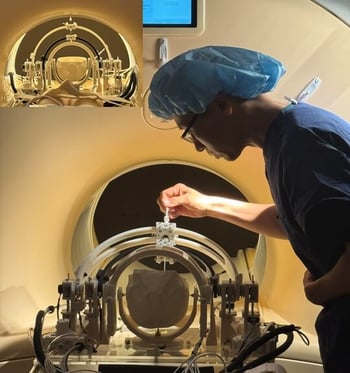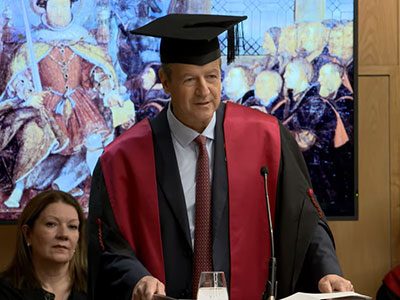
Why BrainBot? Filling a critical gap in neurosurgery
CT-guided interventions in children should be avoided, when possible, due to radiation concerns. MRI is the gold standard in pediatric imaging, offering exceptional soft tissue clarity which is crucial for delicate procedures involving the brain. However, MRI-compatible robotic solutions for precision neurosurgery have not existed—until now.
During a cross-disciplinary brainstorming session, Reza Monfaredi, PhD, medical robotics expert, principal investigator at SZI and the lead inventor of the technology, joined with Chima Oluigbo, MD, neurosurgeon, clinical lead and co-inventor, and Kevin Cleary, PhD, medical robotics and system integration expert, associate technical director at SZI and co-inventor. Together, they identified an unmet critical need: a robotic platform capable of operating entirely within an MRI scanner to guide brain surgeries with real-time imaging and millimetric precision. That pivotal insight led to the creation of BrainBot, a groundbreaking, first-of-its-kind solution now backed by a $2 million NIH grant. This project represents a collaborative effort between Children’s Research Institute, Children’s National Hospital in Washington, D.C., and Cincinnati Children’s Hospital (Children’s Hospital Medical Center).
Dr. Monfaredi is the lead inventor and principal investigator for this project. Besides Dr. Monfaredi and Dr. Cleary (co-inventor), the outstanding technical team of Children’s National Hospital includes Gang Li, PhD, (co-inventor) who is a staff scientist with expertise in medical robotics, Atharva Paralikar, MEng, (co-inventor) who is a staff engineer, Ayush Nankani, MS, EIT, Pavel Yarmolenko, PhD, with expertise in MRI guided systems, and Nicholas Mouzakis with expertise in MRI technologies. Charles Dumoulin, PhD, (co-inventor), professor of radiology, serves as the principal investigator for the Cincinnati effort with Wolfgang Loew (co-inventor), assistant professor at Cincinnati Children’s Hospital, playing a key role in developing custom head coils for Philips and Siemens MRI scanners. The project team has achieved all planned milestones for this four-year R01 grant. With this strong foundation, the project team is preparing to advance toward first-in-human trials.
The innovation: What is BrainBot?
Key features and advantages:
- Real-time MRI guidance: Unlike current methods requiring patients to be moved between rooms, BrainBot enables complete procedures within the MRI bore, significantly reducing risk and improving outcomes.
- Automatic path planning: The developed proprietary path planner generates the safest and most efficient trajectories, taking into account all nearby vascular structures and brain anatomy.
- Submillimeter accuracy: The robot’s needle driver places tools with 0.5 mm precision under the neurosurgeon’s supervision.
- Custom MRI coil integration: A specialized 7-channel head coil enhances image clarity while allowing robotic access—standard diagnostic imaging coils cannot accommodate robotic integration.
- Modular head fixture: Designed for all ages and anatomies, the fixture reduces MRI setup time and improves workflow efficiency.
- Scanner-agnostic platform: Compatible with most MRI systems, increasing accessibility across clinical settings.
How BrainBot stands apart

Currently, neurosurgeons rely on manual stereotactic frames or non-MRI-compatible robots like ROSA. These solutions require multiple steps in separate rooms, with no real-time visualization which can introduce risks associated with ionizing radiation exposure (where CT is used in addition to MRI), lack of precision due to manual operation and long anesthesia exposures due to inefficient workflows.
Devices like ClearPoint, while MRI-compatible, lack robotic automation and are manually adjusted. They offer limited motion (2 degrees of freedom) and are impractical for multi-target procedures like epilepsy treatment, where up to 15 trajectories may be required.
BrainBot will address these issues by offering: fully robotic movement with 4 degrees of freedom, start-to-end procedural capability in the MRI suite, scalability for complex, multi-target procedures, significantly reduced human error and shorter procedure and anesthesia time.
Clinical and commercial potential
The demand for safe, accurate, image-guided brain surgery is growing. Despite the limitations of existing systems, companies like ClearPoint and the makers of ROSA are valued in the billions. BrainBot goes further, offering the comprehensive solution neurosurgeons have been waiting for.
Our technology has already shown strong performance in lab settings and ex-vivo models, and we are now working with the FDA, having initiated the regulatory process and beginning review meetings.
Who should partner with us?
We are actively seeking strategic partners to help bring BrainBot to operating rooms worldwide. Ideal collaborators include:
- Medical device companies expanding into neurosurgical robotics
- MRI manufacturers aiming to broaden MRI use from diagnostics to intervention
- Companies developing MRI-compatible tools (needles, electrodes, etc.)
- Biotech and surgical startups with a focus on advanced imaging and robotic surgery
Funding and future outlook
Backed by a $2 million NIH R01 grant, BrainBot has the momentum to become a transformative technology in the neurosurgery field. A renewal application is already in progress as we prepare for preclinical milestones and eventual clinical trials.
A new era of brain surgery begins
BrainBot represents more than just a surgical tool—it is a bold step into the future of precision medicine. By combining robotic accuracy with the power of real-time MRI imaging, we’re unlocking safer, faster and smarter neurosurgical care for patients of all ages.
Stay tuned—because the future of brain surgery is already in motion.



